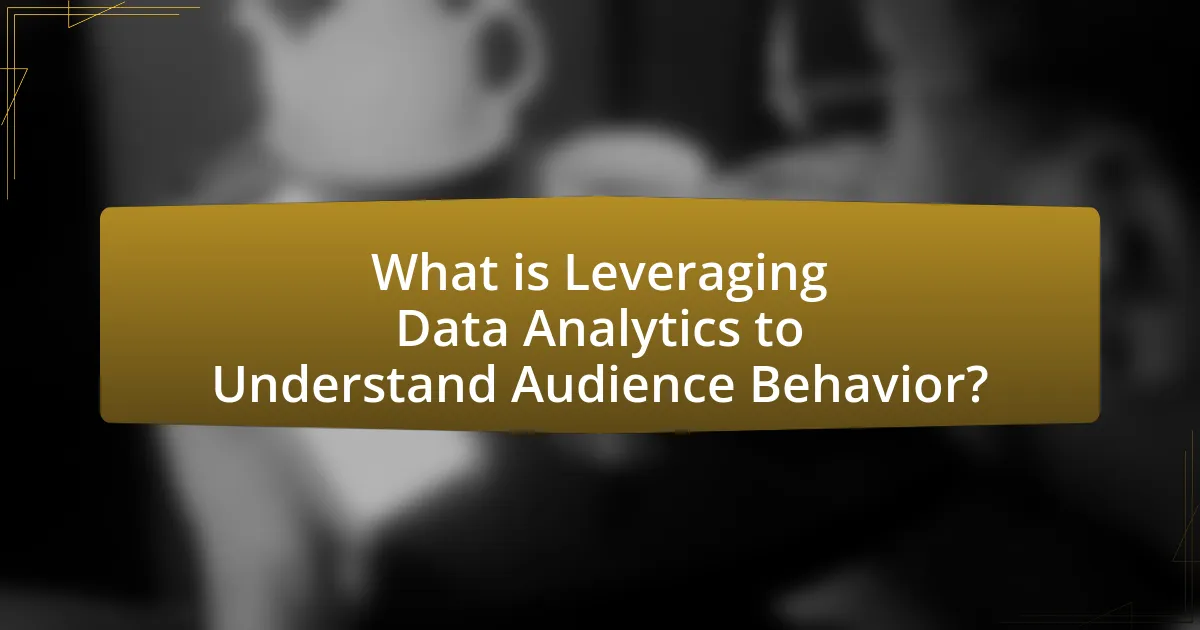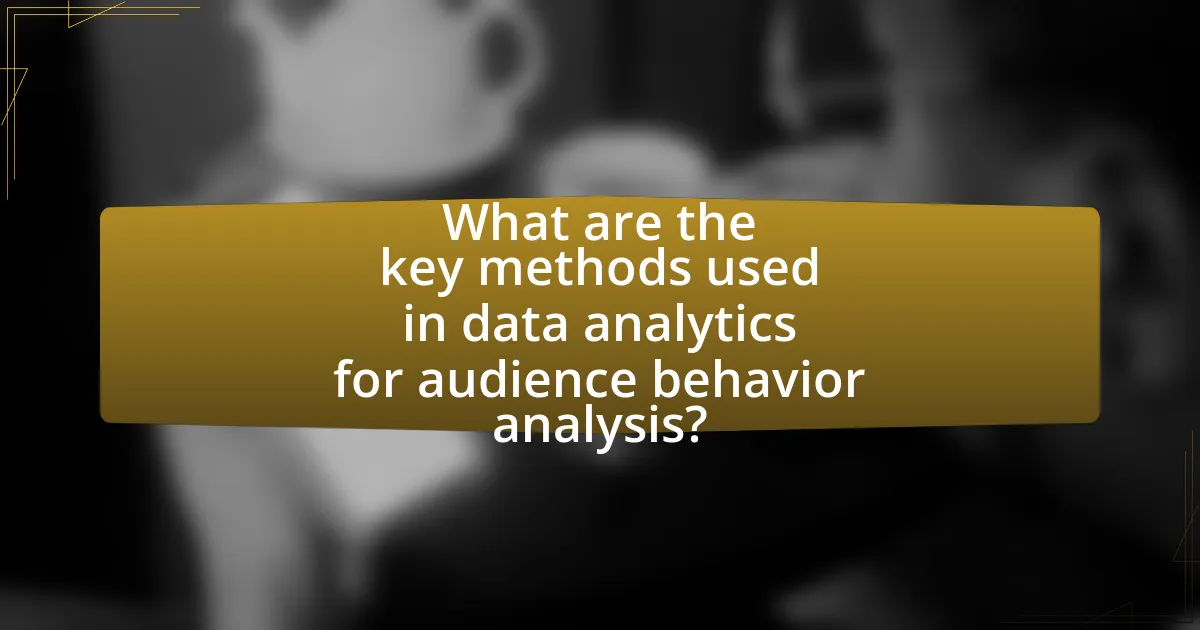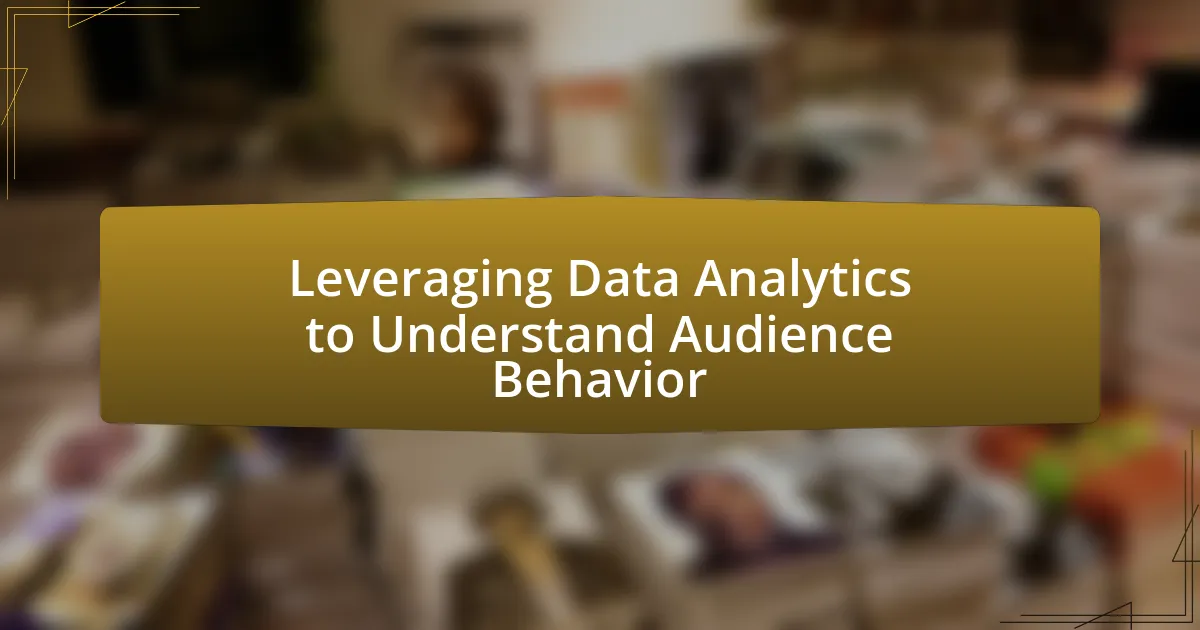Leveraging data analytics to understand audience behavior involves utilizing both quantitative and qualitative data to gain insights into how audiences interact with products, services, or content. The article outlines the importance of data analytics in identifying patterns, preferences, and trends that inform marketing strategies and enhance customer engagement. Key methods discussed include segmentation, predictive analytics, and sentiment analysis, which collectively improve decision-making and marketing effectiveness. Additionally, the article addresses the challenges businesses face in data collection and analysis, such as data quality issues and skill gaps, while providing practical tips for successful implementation of data analytics to drive better audience understanding and business outcomes.

What is Leveraging Data Analytics to Understand Audience Behavior?
Leveraging data analytics to understand audience behavior involves using quantitative and qualitative data to gain insights into how audiences interact with products, services, or content. This process enables organizations to identify patterns, preferences, and trends that inform marketing strategies and enhance customer engagement. For instance, a study by McKinsey & Company found that companies utilizing data analytics effectively can increase their marketing ROI by 15-20%. By analyzing metrics such as website traffic, social media interactions, and purchase history, businesses can tailor their offerings to meet the specific needs of their audience, ultimately driving better results and fostering loyalty.
How does data analytics contribute to understanding audience behavior?
Data analytics significantly enhances the understanding of audience behavior by providing insights into patterns and preferences through the analysis of large datasets. By examining metrics such as engagement rates, purchase history, and demographic information, organizations can identify trends that inform marketing strategies and content creation. For instance, a study by McKinsey & Company found that companies using data analytics effectively can increase their marketing ROI by 15-20%. This demonstrates that data analytics not only reveals what audiences are interested in but also helps predict future behaviors, allowing businesses to tailor their approaches for better engagement and conversion rates.
What types of data are analyzed to gain insights into audience behavior?
To gain insights into audience behavior, various types of data are analyzed, including demographic data, behavioral data, engagement metrics, and psychographic data. Demographic data provides information such as age, gender, and location, which helps in segmenting the audience. Behavioral data tracks user interactions, such as website visits and purchase history, revealing patterns in consumer behavior. Engagement metrics, including likes, shares, and comments on social media, indicate how audiences interact with content. Psychographic data delves into audience interests, values, and lifestyles, offering a deeper understanding of motivations. Collectively, these data types enable businesses to tailor their strategies effectively to meet audience needs.
How do different analytics techniques enhance audience understanding?
Different analytics techniques enhance audience understanding by providing insights into behaviors, preferences, and demographics. Techniques such as segmentation analysis allow marketers to categorize audiences based on shared characteristics, enabling targeted messaging that resonates more effectively. Predictive analytics utilizes historical data to forecast future behaviors, helping organizations anticipate audience needs and tailor their strategies accordingly. Additionally, sentiment analysis processes social media interactions to gauge audience emotions and opinions, offering real-time feedback that can inform content and engagement strategies. These methods collectively improve decision-making and enhance the relevance of marketing efforts, ultimately leading to increased audience engagement and satisfaction.
Why is understanding audience behavior important for businesses?
Understanding audience behavior is crucial for businesses because it enables them to tailor their products, services, and marketing strategies to meet customer needs effectively. By analyzing data on consumer preferences, purchasing patterns, and engagement metrics, businesses can identify trends and make informed decisions that enhance customer satisfaction and loyalty. For instance, a study by McKinsey & Company found that companies that leverage customer behavior insights can increase their marketing effectiveness by up to 30%. This data-driven approach not only improves customer experiences but also drives revenue growth and competitive advantage.
What impact does audience behavior have on marketing strategies?
Audience behavior significantly influences marketing strategies by dictating how brands tailor their messaging, product offerings, and engagement methods. Understanding audience preferences, purchasing habits, and engagement patterns allows marketers to create targeted campaigns that resonate with specific demographics. For instance, a study by McKinsey & Company found that companies that leverage customer behavior data can increase their marketing ROI by up to 15-20%. This data-driven approach enables businesses to optimize their advertising spend, enhance customer experiences, and ultimately drive higher conversion rates.
How can audience insights drive product development?
Audience insights can drive product development by informing design decisions and feature prioritization based on actual consumer preferences and behaviors. By analyzing data from surveys, social media interactions, and purchase history, companies can identify trends and pain points that directly influence product features and enhancements. For instance, a study by McKinsey & Company found that organizations leveraging customer insights in their product development process can achieve up to 20% higher customer satisfaction and 15% increased sales. This demonstrates that integrating audience insights not only aligns products with market demand but also enhances overall business performance.

What are the key methods used in data analytics for audience behavior analysis?
The key methods used in data analytics for audience behavior analysis include segmentation, predictive analytics, and sentiment analysis. Segmentation involves dividing the audience into distinct groups based on shared characteristics, which allows for targeted marketing strategies; for example, demographic segmentation can reveal trends in purchasing behavior among different age groups. Predictive analytics utilizes historical data to forecast future behaviors, enabling businesses to anticipate customer needs and optimize their offerings; studies show that companies using predictive analytics can increase their sales by up to 20%. Sentiment analysis assesses audience opinions and emotions through text data from social media and reviews, providing insights into customer satisfaction and brand perception; research indicates that 79% of consumers trust online reviews as much as personal recommendations. These methods collectively enhance understanding of audience behavior, driving more effective marketing and engagement strategies.
What tools are commonly used for data analytics in audience behavior?
Commonly used tools for data analytics in audience behavior include Google Analytics, Adobe Analytics, and Tableau. Google Analytics provides insights into website traffic and user interactions, allowing businesses to understand audience demographics and behavior patterns. Adobe Analytics offers advanced segmentation and real-time data analysis, enabling deeper insights into customer journeys. Tableau is a powerful data visualization tool that helps in interpreting complex data sets, making it easier to identify trends and patterns in audience behavior. These tools are widely adopted due to their effectiveness in providing actionable insights that drive marketing strategies and improve user engagement.
How do these tools differ in their approach to data analysis?
Different data analysis tools vary in their methodologies, with some focusing on statistical analysis while others emphasize machine learning techniques. For instance, traditional tools like Excel primarily utilize descriptive statistics to summarize data, whereas advanced analytics platforms such as Tableau or Power BI leverage visual analytics to provide insights through interactive dashboards. Additionally, machine learning tools like Python’s Scikit-learn apply algorithms to identify patterns and make predictions based on historical data, which contrasts with the more static analysis of traditional tools. This distinction highlights how the choice of tool can significantly influence the depth and type of insights derived from data analysis.
What are the advantages of using advanced analytics tools?
Advanced analytics tools provide significant advantages, including enhanced decision-making, improved operational efficiency, and deeper insights into audience behavior. These tools utilize sophisticated algorithms and statistical methods to analyze large datasets, enabling organizations to identify trends and patterns that inform strategic choices. For instance, a study by McKinsey & Company found that companies leveraging advanced analytics can increase their productivity by 5-6% and enhance their profitability by 10-15%. This demonstrates that advanced analytics tools not only facilitate better understanding of audience behavior but also drive tangible business outcomes.
How can businesses implement data analytics to understand their audience?
Businesses can implement data analytics to understand their audience by utilizing tools and techniques that analyze customer data, such as demographic information, purchasing behavior, and engagement metrics. By collecting data from various sources like social media, website interactions, and sales records, businesses can create detailed customer profiles and segment their audience effectively. For instance, a study by McKinsey & Company found that companies using advanced analytics can improve their marketing ROI by 15-20%. This demonstrates that leveraging data analytics not only enhances audience understanding but also drives better business outcomes.
What steps should businesses take to start leveraging data analytics?
Businesses should begin leveraging data analytics by first identifying their specific goals and objectives related to data usage. This involves determining what insights they seek to gain, such as understanding customer behavior or improving operational efficiency. Next, businesses should invest in the necessary technology and tools, such as data management platforms and analytics software, to collect and analyze data effectively.
Following this, they should ensure data quality by implementing processes for data cleaning and validation, as accurate data is crucial for reliable insights. Additionally, businesses must foster a data-driven culture by training employees on data literacy and encouraging data-driven decision-making across all levels.
Finally, businesses should continuously monitor and evaluate their analytics strategies, adjusting their approaches based on performance metrics and evolving business needs. This iterative process ensures that they remain aligned with their objectives and can adapt to changes in audience behavior.
How can organizations ensure data quality for accurate analysis?
Organizations can ensure data quality for accurate analysis by implementing robust data governance frameworks. These frameworks establish clear policies and procedures for data collection, storage, and management, which are essential for maintaining data integrity. For instance, regular data audits can identify inconsistencies and inaccuracies, while standardized data entry processes reduce errors. According to a study by the Data Warehousing Institute, poor data quality can cost organizations up to 20% of their revenue, highlighting the importance of investing in data quality measures. By prioritizing data validation techniques and employing automated tools for data cleansing, organizations can significantly enhance the reliability of their analytical outcomes.

What challenges do businesses face when leveraging data analytics for audience behavior?
Businesses face several challenges when leveraging data analytics for audience behavior, including data quality issues, integration complexities, and skill gaps. Data quality issues arise when the data collected is inaccurate, incomplete, or outdated, leading to misleading insights. Integration complexities occur when businesses struggle to combine data from various sources, which can hinder a comprehensive understanding of audience behavior. Additionally, skill gaps in data analysis and interpretation can prevent organizations from effectively utilizing analytics tools, as a lack of expertise may result in underutilization of valuable data. According to a report by McKinsey, 70% of organizations cite a lack of skilled personnel as a significant barrier to successful data analytics implementation.
What are the common obstacles in data collection and analysis?
Common obstacles in data collection and analysis include data quality issues, lack of standardization, privacy concerns, and resource limitations. Data quality issues arise when the information collected is inaccurate or incomplete, leading to unreliable analysis. Lack of standardization can hinder the integration of data from different sources, making it difficult to draw meaningful insights. Privacy concerns often restrict access to data, especially personal information, which can limit the scope of analysis. Resource limitations, including insufficient funding and personnel, can impede the ability to collect and analyze data effectively. These obstacles can significantly impact the effectiveness of leveraging data analytics to understand audience behavior.
How can data privacy concerns affect audience behavior analysis?
Data privacy concerns can significantly hinder audience behavior analysis by limiting the data available for analysis. When individuals are apprehensive about how their personal information is collected and used, they may opt out of data-sharing practices or provide inaccurate information, leading to incomplete datasets. For instance, a survey by the Pew Research Center found that 79% of Americans are concerned about how their data is being used by companies, which directly impacts the quality and reliability of audience insights derived from analytics. Consequently, businesses may struggle to accurately understand consumer preferences and behaviors, ultimately affecting their marketing strategies and decision-making processes.
What strategies can mitigate the challenges of data interpretation?
To mitigate the challenges of data interpretation, employing data visualization techniques is essential. Data visualization simplifies complex datasets, making patterns and trends more accessible for analysis. For instance, studies show that visual representations can improve comprehension by up to 80%, as they allow stakeholders to quickly grasp insights that might be obscured in raw data. Additionally, implementing standardized data definitions and frameworks ensures consistency in interpretation across teams, reducing ambiguity and miscommunication. Research indicates that organizations using standardized metrics experience a 25% increase in decision-making efficiency. Finally, fostering a culture of continuous learning and training in data literacy equips team members with the skills necessary to interpret data accurately, further enhancing the overall effectiveness of data-driven strategies.
How can businesses overcome these challenges effectively?
Businesses can effectively overcome challenges in leveraging data analytics to understand audience behavior by implementing robust data management systems and investing in advanced analytical tools. These systems enable businesses to collect, store, and analyze large volumes of data efficiently, ensuring that insights are accurate and actionable. For instance, companies that utilize customer relationship management (CRM) software can track customer interactions and preferences, leading to more personalized marketing strategies. According to a study by McKinsey, organizations that harness data analytics can improve their marketing ROI by 15-20%, demonstrating the tangible benefits of effective data utilization. Additionally, training employees in data literacy equips them with the skills necessary to interpret data insights, fostering a data-driven culture that enhances decision-making processes.
What best practices should be followed for successful data analytics implementation?
Successful data analytics implementation requires a clear strategy, robust data governance, and continuous evaluation. Establishing a clear strategy involves defining specific goals and objectives that align with business needs, ensuring that analytics efforts are focused and relevant. Robust data governance ensures data quality, security, and compliance, which are critical for reliable insights; according to a 2020 Gartner report, organizations with strong data governance are 2.5 times more likely to achieve their analytics goals. Continuous evaluation of analytics processes and outcomes allows organizations to adapt and improve their strategies based on performance metrics and changing market conditions.
How can continuous learning improve audience behavior insights?
Continuous learning enhances audience behavior insights by enabling organizations to adapt and refine their understanding of audience preferences and trends over time. This iterative process allows for the integration of new data and feedback, which leads to more accurate and timely insights. For instance, companies that utilize machine learning algorithms can analyze vast amounts of audience interaction data, continuously updating their models to reflect changing behaviors. Research from McKinsey indicates that organizations that embrace continuous learning can improve their decision-making speed by 5 to 10 times, thereby gaining a competitive edge in understanding audience dynamics.
What practical tips can enhance the effectiveness of data analytics in understanding audience behavior?
To enhance the effectiveness of data analytics in understanding audience behavior, organizations should implement segmentation, utilize predictive analytics, and ensure data quality. Segmentation allows businesses to categorize audiences based on demographics, interests, and behaviors, leading to more targeted insights. Predictive analytics leverages historical data to forecast future behaviors, enabling proactive strategies. Ensuring data quality is crucial, as accurate and clean data leads to reliable analysis; according to a study by IBM, poor data quality costs organizations an average of $15 million annually. By focusing on these practical tips, organizations can significantly improve their understanding of audience behavior.

Leave a Reply